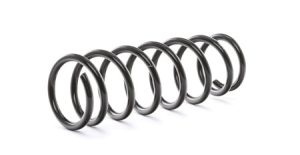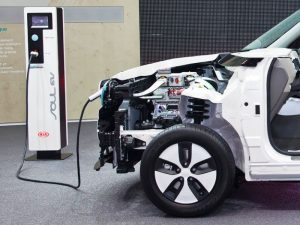As the global automotive industry shifts toward electric and hybrid mobility, every component of a vehicle — including the suspension system — is being reconsidered. One often-overlooked part of this evolution is the suspension spring. While their primary function remains the same, the design, material, and behavior of springs in EVs (electric vehicles) and HEVs (hybrid electric vehicles) are undergoing significant changes to meet unique performance, weight, and safety demands.
So, are the suspension springs in electric and hybrid vehicles different? The short answer is yes — and this article explores how and why.
What Are Suspension Springs and Why Are They Important?

Suspension springs are critical components in a vehicle’s suspension system. They:
-
Support the vehicle’s weight
-
Maintain ride height
-
Absorb road irregularities
-
Work with dampers to provide ride comfort and handling
In EVs and hybrids, these functions become more critical due to battery weight, instant torque delivery, and regenerative braking systems.
Key Differences in Suspension Demands for EVs & Hybrids
EVs and hybrids place different loads and stresses on suspension systems compared to conventional internal combustion engine (ICE) vehicles.
| Factor | Impact on Suspension Springs |
|---|---|
| Heavier battery packs | Requires stiffer or reinforced springs |
| Regenerative braking | Increased front load during deceleration |
| Instant torque delivery | Demands better traction and body control |
| Different weight distribution | Alters spring tuning front-to-rear |
| Quieter cabin | Suspension noise is more noticeable |
How Suspension Springs in EVs and Hybrids Differ
1. Spring Stiffness and Load Handling
EV batteries can add 200–500 kg or more to a vehicle. As a result, EV and hybrid springs often have:
-
Higher spring rates to handle added mass
-
Progressive spring designs for better comfort and load adaptability
-
Reinforced coils or thicker material
2. Material Innovations
To offset the battery weight, manufacturers seek lightweight spring materials, such as:
| Material | Benefit | Typical Use |
|---|---|---|
| High-tensile steel | Strong and cost-effective | Most hybrids & EVs |
| Composite springs | Up to 60% lighter than steel | Premium electric models |
| Fiberglass-reinforced polymers | Corrosion resistance | Concept and high-end vehicles |
3. Air Suspension in EVs
Several EVs now come equipped with air springs or adaptive air suspension systems, offering:
-
Adjustable ride height
-
Load-leveling features
-
Enhanced aerodynamic efficiency at high speeds
Examples:
-
Tesla Model S and X
-
Audi e-tron
-
Mercedes EQS
4. Front vs. Rear Spring Tuning
Due to battery placement (often under the floor or rear), hybrids and EVs may have altered weight distribution.
| Placement | Effect on Spring Design |
|---|---|
| Rear-biased battery | Stiffer rear springs, softer front |
| Evenly distributed | Balanced spring rate front-to-rear |
| Front-heavy hybrids | Reinforced front coil springs |
Proper tuning ensures handling stability and even tire wear.
Integration with Regenerative Braking
Regenerative braking shifts load toward the front axle. This requires:
-
More robust front springs
-
Tighter damper pairing to control pitch and dive
-
Reduced rebound travel to prevent instability
Challenges and Engineering Considerations
-
Weight vs. Efficiency
-
Heavier springs can hurt efficiency and range.
-
Lightweight composite materials reduce unsprung mass.
-
-
Noise, Vibration & Harshness (NVH)
-
With no engine sound, spring-related noises are more noticeable.
-
EV springs often include rubber isolators or dual-rate designs.
-
-
Durability under High Torque
-
Instant electric torque demands better body control.
-
Stiffer springs help reduce squat under acceleration.
-
Comparison Table: Spring Specs by Vehicle Type
| Feature | ICE Vehicles | Hybrid Vehicles | Electric Vehicles |
|---|---|---|---|
| Spring Rate | Standard | Moderate increase | High or progressive |
| Material | Steel | High-tensile steel | Steel or composite |
| Suspension Type | Coil or leaf | Coil + occasional air | Coil or air suspension |
| Noise Isolation | Basic | Moderate | Enhanced (for NVH) |
| Load Distribution | Front-heavy | Front-biased | Even or rear-biased |
Signs Your EV or Hybrid Needs Spring Replacement
Just like conventional cars, EV and hybrid suspension springs can wear out. Watch for:
-
Uneven or sagging ride height
-
Increased body roll or bounce
-
Loud clunks or creaks from suspension
-
Reduced range or performance due to excessive squat
Tips When Replacing EV or Hybrid Springs

-
Always choose springs engineered for your specific vehicle model and powertrain.
-
Avoid retrofitting ICE vehicle springs into EVs — they may not support the extra weight.
-
Pair new springs with matching shocks or struts for balanced performance.
-
After replacement, recheck alignment and ride height.
Where to Buy High-Quality EV & Hybrid Springs
Looking for OEM-quality or performance suspension parts for your electric or hybrid car?
Buy Springs & Components online
This online shop offers a wide range of suspension springs compatible with EVs, plug-in hybrids, and hybrid vehicles from major brands like Tesla, Toyota, BMW, Hyundai, and more. Filter by make and model for guaranteed fit.
Final Thoughts
While the core function of suspension springs remains unchanged, electric and hybrid vehicles have introduced new challenges and demands. From weight management to noise isolation and adaptive response, modern spring systems must evolve alongside drivetrain technology.
Whether you’re maintaining a hybrid sedan or upgrading a high-performance EV, understanding how suspension springs are tailored to electric mobility will help you make smarter, safer, and more efficient decisions.
Ready to upgrade or replace your EV or hybrid suspension springs? Make sure you’re choosing components designed with modern mobility in mind.